kottke.org posts about design
The deadline for entering the Winterhouse Awards for Design Writing & Criticism is nearing. Get your entries in by June 1.
The Writing Award of $10,000 is open to writers, critics, scholars, historians, journalists and designers and given for a body of work. The Education Award of $1,000 is open to students (high school, undergraduate or graduate) whose use of writing in a single essay demonstrates originality and promise.
A brand timeline portrait shows all the different brands a person uses and interacts with during the course of a typical day.

Originated by Jane Sample, dozens of other people have also created portraits. (via rocketboom)
Update: Make your own at Brand My Day.
Nice black and white covers for science fiction books.
“Sanda created each cover using A4 paper, with all the typography printed and placed on the structure by hand,” Jones continues. “We then photographed each paper structure and, upon seeing the original black and white images, we didn’t feel that any tweaking or further alterations were needed.”
The hole punch one is my favorite. (thx, conor)
The Ministry of Type highlights a small but significant feature on the UI of the Xerox Star, a computer with an early GUI: precise positioning of icons on a dithered background in order to avoid rough edges.
It may be subtle, but it’s the kind of thing that reduces the overall apparent quality of your work, the stuff that marks out your work as being standard (read: mediocre) or exceptional. If you feel you shouldn’t get precious about such things, perhaps graphic design isn’t your thing.
There’s very little information about this online, but here’s what I’ve scraped together. Milton Glaser: To Inform and Delight is a documentary on the legendary designer and it will be released in theaters sometime near the end of May. You know, one of those huge summer blockbusters.
I posted about Glaser’s Ten Things I Have Learned several years ago, mostly for point #5’s rejoinder to “less is more”: “Just enough is more”. Rereading it now, I’m much more interested in some of the other points, particularly 1-3.
And the important thing that I can tell you is that there is a test to determine whether someone is toxic or nourishing in your relationship with them. Here is the test: You have spent some time with this person, either you have a drink or go for dinner or you go to a ball game. It doesn’t matter very much but at the end of that time you observe whether you are more energised or less energised. Whether you are tired or whether you are exhilarated. If you are more tired then you have been poisoned. If you have more energy you have been nourished. The test is almost infallible and I suggest that you use it for the rest of your life.
The Ministry of Type has a look at The St. John’s Bible, a modern-day hand-lettered Bible.
Jackson has brought together an incredible range of styles for the bible, from rich, lush, gold-encrusted illuminations reminiscent of Eastern Orthodoxy to crisp and spare compositions more like the modern style of the Church of England (to my mind at least).
Looks nice. A Heritage Edition is available for $145,000.
Recently a number of efforts have been made at re-imagining the packaging for movies, books, video games, and other media, mostly mashups and in the illustration style of typical of Saul Bass’ movie posters or Penguin Classics book covers. I’ve collected several examples below.
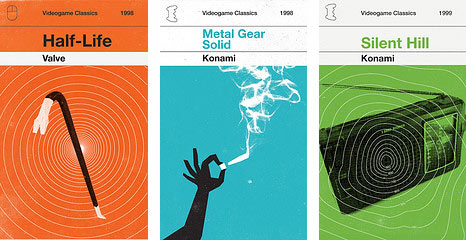
Olly Moss made Penguin-like book covers for video games like Ocarina of Time and Half-Life.
M. S. Corley made Penguin-like versions of the Harry Potter books.
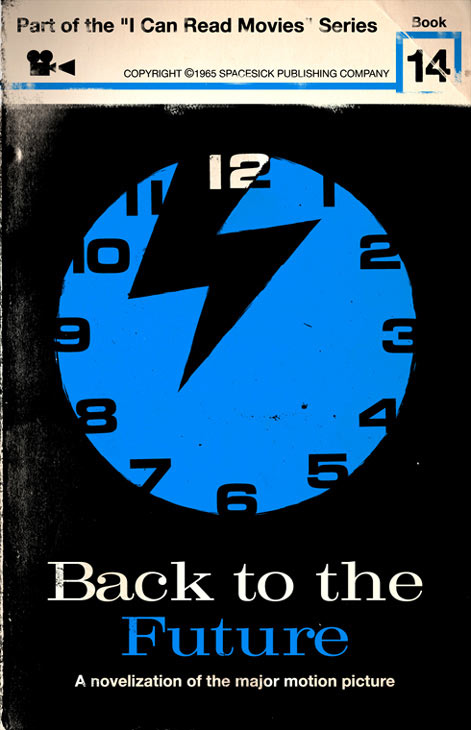
In his I Can Read Movies series, spacesick imagines Penguin-like book covers for movies like Close Encounters of the Third Kind, Sixteen Candles, and Back to the Future.
Forrest Lucero designed Penguin-like book covers for songs from The Postal Service and Daft Punk.
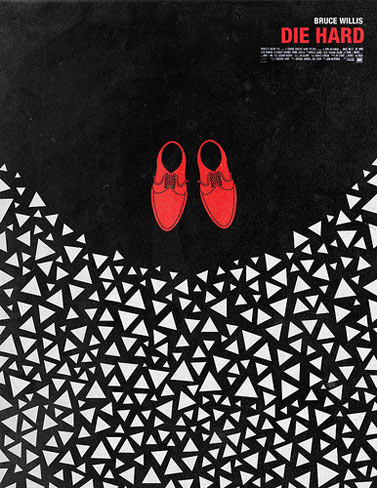
Olly Moss also did simple red/white/black posters for some of his favorite movies, including Die Hard and The Deer Hunter.
A bunch of people on Flickr imagined Nintendo DS tie-in games for movies like Andy Warhol’s Empire, Eyes Wide Shut, and 8 1/2. They also did some for TV shows, magazines, web sites, and all sorts of other media.
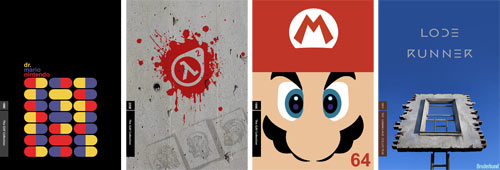
The folks on the NeoGAF message board made Criterion Collection-style box art for video games like Super Mario Galaxy, Black and White, and Super Mario 64.
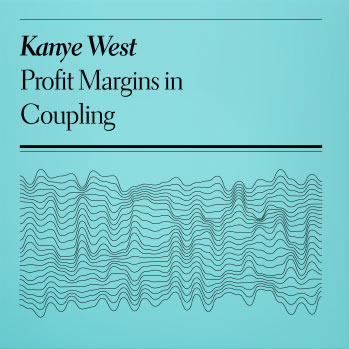
Nikolay Saveliev made simple two-color album covers for the likes of Kanye West, Jessica Simpson, and Franz Ferdinand.
Update: Modernist editions of classic album covers. (thx, zach)
Update: Logan Walters is redoing Wu-Tang Clan album covers.
Update: Classic albums reimagined as Pelican books.
Update: Simple Star Wars posters.
Update: Brandon Schaefer did some simple Blu-ray sleeve for movies, very much in the style of Olly Moss. Exergian did some posters for TV shows; the one for Weeds is particularly nice.

Update: Books as web services.
Update: Panic made some Atari 2600-themed packaging for their software. (thx, daniel)
The spouting bean concept illustrated by Jillian Tamaki for the “Green Chicago” issue of Hemispheres, the inflight magazine for United Airlines, is a little bit of genius.
From an interview by Kicker Studio of London designer Crispin Jones, where he says that the broad definition of design is perhaps not so bad.
On one level design is horribly inarticulate word - it has no real meaning nor way of encompassing all the things that are classed as “design”. This weakness however means that the discipline is kind of without boundaries. I think design allows you to engage with the contemporary world and engage in shaping the world: we’re living in a golden age of products/services as technology matures and people integrate it into their lives.
You may have picked up on this by reading kottke.org over the years, but I think that designers, architects, entrepreneurs, filmmakers, writers, scientists, et al. are all engaged in doing the same kind of thing, more or less, and that working “without boundaries” and borrowing the best aspects of many disciplines is one of the keys to maximizing your creative potential. (thx matt)
Cliff Kuang traces the evolution of office designs from the open factory-like floors of Frederick Taylor to the present era of semi-private pods.
Adrian Shaughnessy shares ten paradoxes about graphic design; by paradox he means “an opinion or statement contrary to commonly accepted wisdom”. I particularly liked these two bits of wisdom:
As part of their training, all designers should be obliged to spend a sum of their own money on graphic design.
And:
If we want to make money as a graphic designer, we must concentrate on the work — not the money.
Long-running design blog Speak Up will cease publication later this week.
Earlier this year, Bryony and I made the decision to close Speak Up. Seeing weeks and weeks go by where we have only two or three posts (and one of them being the Quipsologies round-up) has become too painful for us. It’s also like watching Ozzy Ozbourne today, still holding on to that rock glory but he can’t really rock no more, not like he used to.
If the glass Heinz ketchup bottle were introduced today, it would likely be disparaged because it doesn’t work very well as a ketchup dispenser. But since it’s been around so long, people love it.
Like the Apple iPod, a Rawlings baseball and 3M’s Post-it Notes, Heinz Ketchup is a rare example of a best-selling brand that is also generally considered to be best in class. It would seem silly to splash out on a more expensive alternative, especially as the glass bottle affirms its stellar status.
That is why Heinz Tomato Ketchup is one of the very few branded products you see in its original packaging in expensive restaurants. “Sometimes we have to accept that we can’t better something that already exists,” said Jeremy King, who co-owns The Wolseley in London and is now re-opening The Monkey Bar in New York. “When a customer asks for ketchup they generally want Heinz. The iconic glass bottle reassures them that they are getting it.” Quite a coup for something that does not really do its job properly.
ps. He-ketchup for manly men.
Update: Daniel Eatock Everything Heinz project:
An edition of 57 sealed cans each containing a composite mix of 57 Heinz canned foods.
(thx, andy)
Some interesting moments from the Objectified screening last night.
- Rob Walker, who writes the Consumed column for the NY Times Magazine, was my favorite person in the movie. I particularly liked his idea for a million-dollar marketing campaign for the stuff we already own. Paraphrasing from memory: “You already own all these wonderful things. Enjoy them today.”
- The best comment during the Q&A after the film was from a man who said that the film made him feel physically sick. Not that the movie was bad but that it was powerful. The man was a product designer and the film raised a lot of issues for him with regard to the waste — both physical trash and human energy, if I was catching his drift correctly — produced during the course of making these billions of mass produced items, most of which end up in landfills in pretty short order. He seemed to be asking himself and the audience: how can we, as designers, in good conscience, keep doing this to ourselves?
- The film addressed that question a bit at the end as did the panelists during the Q&A. Dan Formosa of Smart Design, echoing Walker’s marketing idea, said that some designers in the future will shift from designing new products and start to design experiences for people to make better decisions about the objects they introduce into their lives or to better utilize the products they already have. The sales and support process at many many product companies are ripe for a designer’s guiding hand. It’s mind-boggling to me that companies spend billions and billions of dollars designing and building products and then leave the selling of those products to sales people who are largely untrained and unmotivated and the support to a call center in Bangalore. Zappos, Apple, Amazon, and similar companies have realized this with spectacular results.
- What didn’t work for me: 1) The IDEO stuff. They had 12 people brainstorming about how to build a better toothbrush that people won’t throw away and in addition to all of the time they’re spending talking about it, they went through dozens of Post-It notes, and had purchased what looked like hundreds of toothbrushes for research purposes that were likely to get thrown away as well. The whole thing seemed super wasteful (and maybe that was the point of showing it). 2) Karim Rashid. He said a lot of things that sounded good but when you look at his work, I don’t know that he actually believes any of it. 3) Marc Newson. What the hell was he on about?
If you’re interested, check out the trailer. You can also download the groovy song from the trailer and the film’s opening credits…it’s called I Like Van Halen Because My Sister Says They Are Cool by El Ten Eleven.
Tomorrow at 3pm ET: Layer Tennis match between Jennifer Daniel and Jillian Tamaki with commentary by some guy named Jason Kottke. What is Layer Tennis?
Two competitors will swap a file back and forth in real-time, adding to and embellishing the work. Each artist gets fifteen minutes to complete a “volley” and then we post it to the site live. A third participant, a writer, provides play-by-play commentary on the action, as it happens. A match lasts for ten volleys.
Update: Here’s the match preview.
In a 1989 interview for Dutch television, Pixies frontman Frank Black talks about his songwriting process as creating a “poetic structure” with the melody and letting the lyrics flow from there. The Dutch graphic design studio Experimental Jetset took inspiration from Black’s approach.
When we get an assignment (which usually comes in the form of a question, a theme, a problem or a riddle), we feel as if the solution is already enclosed in the assignment itself. The design is already there; it just has to be released. Like the fist from Frank Black’s shirt.
In the month and a half after the awful redesign of their packaging, sales of Tropicana’s Pure Premium orange juice dropped 20%. !!! Same juice, different package, 20% fewer sales.
Tropicana had certainly sought to create excitement around the Pure Premium rebrand, announcing Jan. 8 a “historic integrated-marketing and advertising campaign … designed to reinforce the brand and product attributes, rejuvenate the category and help consumers rediscover the health benefits they get from drinking America’s iconic orange-juice brand.”
Who knows what the proper conclusions are to draw from all this. Did sales drop because glancing shoppers couldn’t tell Tropicana from a generic store brand? Does this underscore the importance of good design? Or should we beware of what seems like good design but turns out to be a bunch of metaphorical subterfuge? Did PepsiCo do this on purpose, a la the New Coke conspiracy? Are people stupid because they focus more on orange juice packaging than the actual juice when making buying decisions? (via df)
Designer Naoto Fukasawa has designed juice boxes that both look and feel like their juices’ fruits of origin. That newly-reinstated orange on Tropicana cartons is turning green with envy.
I’m a classy roustabout, but I’m not sure I’d want to accessorize my computer with the pink-accented Swarovski Crystal mouse.
By manipulating the design of an item used everyday into a sensual, feminine form, we have created a personal gesture for the urban lifestyle of the working woman.
Kind of the opposite of the more organic, but equally impractical Mouse Mouse.
via design bloom
Pull one of these out at a bar and jaws will start wagging.
Designed by Michael Häne & Remo Caminada.
Attention milk product enthusiasts: The 2009-2014 World Outlook for 60-Milligram Containers of Fromage Frais has been released, and it won the dubious distinction of the Bookseller/Diagram Prize for Oddest Book Title of the Year.
The benefits of winning the award appear to be few. According to Philip Stone, The Bookseller’s charts editor:
“What does the future hold for these items?” Mr. Stone asked, speaking of fromage-frais cartons. “Well, given that fromage frais normally comes in 60-gram containers, one would assume that the world outlook for 0.06-gram containers of fromage frais is pretty bleak. But I’m not willing to pay £795 to find out.”
For those of you who are more into designer accessories than dairy almanacs, the Calf & Half pitcher lets you pour with udder abandon.
And if you’re looking for more clandestine cream, bring your own containers. Raw milk, once our only option, then treated as a potential health hazard, now finds itself on the black market.
Brooke Inman’s Everything Color Circle is mesmerizing. As somebody with limited organizational skills, I find it mind-boggling that she was able to put this together. And to think that it could be destroyed in a nanosecond if a sugar-addled kindergartner armed with construction paper wandered into the room. (via design milk)
Remember the gilded age before The Recession? Well, for those of you still untouched by the meltdown, there’s always the $75K rhinestone toilet by designer Jemal Wright.
Thanks to Luxury Property Blog, you can peruse a list of the Most Expensive Luxury Interiors to aid you in the always-fashionable sport of conspicuous consumption. My personal favorite is from designer Andre Kim: a garish Samsung washing machine featuring baroque paneling and a gilded thingamajig on the door.
For the more utilitarian aristocrat suffering from paranoia, or those who have committed investor fraud and fear angry mobs seeking money for better torches, why not build a panic room for your palace? Constructing a basic model in your home should only cost you about $50K, which is chump change compared to the price tag on the aforementioned sparkly loo.
Jeremy Mickel shares the story of making his first font, which took him about a year and a half.
But then a funny thing happened. I kept correcting and correcting, and all of a sudden I had sanitized the font and there was almost no personality left in it. What I was left with might as well have been VAG Rounded. In a very early draft, I had played with the idea of exaggerating the swellings in the strokes from the original sign. Now I resurrected that, and found the true character of the font.
The result was Router. I also liked this bit:
It’s been said that type design is the art of making unequal things appear equal. Noordzij’s theory of the Stroke of the Pen is apparent even in monoweight sans-serifs. Flip Helvetica’s A, V, or W sideways, and you’ll see that the diagonal strokes are slightly unequal. Rotate the O in Futura, which I was always told was a perfect circle, and you’ll see why that’s not true.
(via shaun inman)
How should a company like Google approach design? By the numbers?
A designer, Jamie Divine, had picked out a blue that everyone on his team liked. But a product manager tested a different color with users and found they were more likely to click on the toolbar if it was painted a greener shade.
As trivial as color choices might seem, clicks are a key part of Google’s revenue stream, and anything that enhances clicks means more money. Mr. Divine’s team resisted the greener hue, so Ms. Mayer split the difference by choosing a shade halfway between those of the two camps.
Her decision was diplomatic, but it also amounted to relying on her gut rather than research. Since then, she said, she has asked her team to test the 41 gradations between the competing blues to see which ones consumers might prefer.
Or in the hands of artist practitioners?
Without a person at (or near) the helm who thoroughly understands the principles and elements of Design, a company eventually runs out of reasons for design decisions. With every new design decision, critics cry foul. Without conviction, doubt creeps in. Instincts fail. “Is this the right move?” When a company is filled with engineers, it turns to engineering to solve problems. Reduce each decision to a simple logic problem. Remove all subjectivity and just look at the data. Data in your favor? Ok, launch it. Data shows negative effects? Back to the drawing board. And that data eventually becomes a crutch for every decision, paralyzing the company and preventing it from making any daring design decisions.
In many cases, I’d trust a good designer with 10 years of experience over The Numbers™. That 10 years represents an internalization of thousands of instances of The Numbers across a broad range of experience. At other times, the quantitative approach is useful. Part of being an effective designer (or an auto mechanic or an engineer or programmer etc.) is learning to recognize the right mixture of the two approaches.
The Very Hungry Caterpillar was one of my favorite books when I was a kid and I’ve loved reading it to Ollie over the past few months. So of course, Google’s logo today is aces.
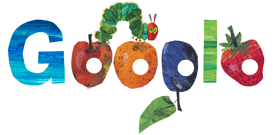
Now do Cloudy with a Chance of Meatballs!
Jared Spool reveals that a simple yes/no question added to Amazon’s site brought in an additional $2.7 billion in revenue.
Amazon had reviews from the very first day. It’s always been a feature that customers love. (Many non-customers talk about how they check out the reviews on Amazon first, then buy the product someplace else.) Initially, the review system was purely chronological. The designers didn’t account for users entering hundreds or thousands of reviews.
For small numbers, chronology works just fine. However, it quickly becomes unmanageable. (For example, anyone who discovers an established blog may feel they’ve come in at the middle of a conversation, since only the most recent topics are presented first. It seems as if the writer assumed the readers had read everything from the beginning.)
The reviews of reviews are really helpful when buying. Personally, I always check out four types of reviews on Amazon in roughly this order:
1) most helpful/highest rated, 2) most helpful/lowest rated, 3) least helpful/highest rated, 4) least helpful/lowest rated
Sometimes reading a really negative review which many people think is spectacularly wrong can help make a useful buying decision.
See also the $300 million button and Cynical-C’s new series on one-star reviews of classic books, movies, and music: To Kill a Mockingbird and Sgt. Pepper’s Lonely Hearts Club Band. (via designnotes)
Update: There is also the Billion Dollar HTML Tag.
This phenomenon is best illustrated by a single design tweak to the Google search results page in 2000 that Mayer calls “The Billion Dollar HTML Tag.” Google founders Sergey Brin and Larry Page asked Mayer to assess the impact of adding a column of text ads in the right-hand column of the results page. Could this design, which at the time required an HTML table, be implemented without the slower page load time often associated with tables?
Mayer consulted the W3C HTML specs and found a tag (the “align=right” table attribute) that would allow the right-hand table to load before the search results, adding a revenue stream that has been critical to Google’s financial success.
A couple of months ago, Jessica Helfand posted a list of 10 things that needed to be redesigned. Her list included the hearse, plastic packaging, and IRS forms. Fast Company recently asked a few other designers what they thought was in need of fixing.
How about it? What would you like to see redesigned? (More than one-line answers appreciated.)
Newer posts
Older posts













Stay Connected